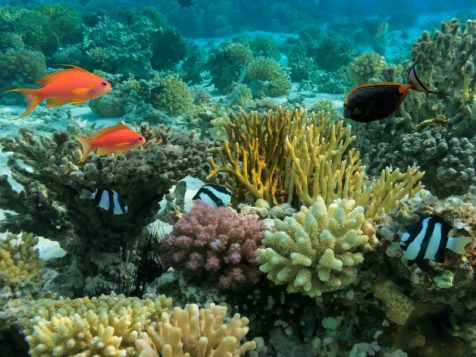Bar Reef Marine Santuary is the most famous and the largest coral reef in Sri Lanka, located two kilometers off the coast of Kalpitiya, once a historical place with a past as a royal port for many centuries. More specifically, it is in the Mannar District in northern Sri Lanka, close to the Jaffna area. It is a system of patch reefs composed mostly of plate corals among others.
It is also beset by deeper sandstone reefs and seagrass beds. Please see the Hikkaduwa Reef entry for more information on these habitats. Diving or using a glass-bottomed boat to tour Bar Reef is one of the best things to do in Sri Lanka on the west coast. However there are no sandy areas to rest during a dive, and thus only the most experienced swimmers are asked to explore the reef. Also, the rarity of sandy areas means that dropping anchor is not at all advised. Coral can be damaged easily under the weight of a metal anchor. On calm days, the sea is incredibly clear and sunlit, with not much debris and sediment floating through the water. Hard corals are the main building blocks of coral reefs, and they grow in shallow water to feed the algae that grow inside them. Please see the Hikkaduwa Reef entry for more information about the dynamics of reefs and their ecosystem.
The traditional denizens of a reef are small, colorful shrimp, crabs and numerous species of detrivorous polycheate worms in the case of animals capable of movement, but sessile animals also live here among the corals. These include tunicates and marine sponges, both filter-feeders. The fish here include the traditional reef fish of the Indian Ocean. Among these are butterflyfish, angelfish and other small, colorful exotic creatures. Some of the largest predators native to the reef include the slow-moving thick-lipped groupers.
The ubiquitous blacktip reef shark also lives at Bar Reef Marine Santuary. See the Hikkaduwa entry for more on this curious carnivore.
Pods of dolphins also hunt offshore.
These are pelagic creatures that would rather range into deeper, open waters but they occasionally have successful hunts in the shallows. Even larger cetaceans will visit Bar Reef. The tropics are the breeding grounds of the mostly cosmopolitan, migrant great whales while most smaller cetaceans like porpoises and dolphins are quite free-ranging too. Bottlenose, spinner, common and spotted dolphins all occur in our waters. They are the most well-known and ‘classic’ dolphins, with the traditional delphinid shape that includes a cylindrical, muscular body and narrow beaked jaws. Another marine mammal that occurs off the Bar Reef coast is the dugong. It lives all around the Indian Ocean, swimming slowly through the shallows while it grazes on seagrass and other plants. Dugong are gentle animals, gentler by far than the swift, predatory dolphins and whales.
In 1998, the reef was subject to a major bleaching event but it took only a few years for it to bounce back. Coral bleaching is a mass die-off where the coral polyps lose their color and turn white due to extreme temperature differences, pollution or other such reasons.
Written by Vasika Udurawane for Travel Lanka Compass



0 Comment